A Modified Generalized Laguerre Spectral Method for Fractional Differential Equations on the Half Line
Abstract
This paper deals with modified generalized Laguerre spectral tau and collocation methods for solving linear and nonlinear multiterm fractional differential equations (FDEs) on the half line. A new formula expressing the Caputo fractional derivatives of modified generalized Laguerre polynomials of any degree and for any fractional order in terms of the modified generalized Laguerre polynomials themselves is derived. An efficient direct solver technique is proposed for solving the linear multiterm FDEs with constant coefficients on the half line using a modified generalized Laguerre tau method. The spatial approximation with its Caputo fractional derivatives is based on modified generalized Laguerre polynomials with x ∈ Λ = (0, ∞), α > −1, and β > 0, and i is the polynomial degree. We implement and develop the modified generalized Laguerre collocation method based on the modified generalized Laguerre-Gauss points which is used as collocation nodes for solving nonlinear multiterm FDEs on the half line.
1. Introduction
Due to the fact that fractional calculus has extensive applications in chemistry, engineering, neuron modeling, and biological sciences, the use of fractional calculus has attracted great interest from the mathematical science research community (e.g., see [1–5]).
As is well known, spectral methods use orthogonal polynomials as the basis functions and so usually provide accurate numerical results, see [6–9] and the references therein. In particular, we could employ tau and pseudospectral modified generalized Laguerre approximations and interpolation to solve multiterm fractional differential equations on semi-infinite interval. However, some authors developed the modified generalized Laguerre spectral method for the half line for ordinary, partial, and delay differential equations, see [8, 10–12]. The Laguerre polynomials of fractional orders and its generalization can be expressed by the Bell polynomials, see [13–15].
Because of the difficulty in obtaining exact solutions to many fractional differential equations, there is a large number of papers dealing with the numerical solution of fractional differential equation [16–21]. The usual spectral methods based on Legendre, Chebyshev, and Jacobi polynomials are only available for bounded domains for the numerical solution of FDEs [22, 23]. In [22, 24, 25], the authors discussed the operational matrices of Caputo fractional derivatives of shifted Chebyshev and Jacobi polynomials with spectral techniques to provide numerical approximations to the solution of linear and nonlinear multiterm FDEs on finite intervals. Ahmadian et al. [26] applied the Jacobi operational matrix to present an efficient algorithm for solving a class of fuzzy FDEs. Li et al. [27] employed spectral approximations to compute the fractional integral and the Caputo derivative; they also presented pseudospectral approximation for a class of FDEs. Yüzbaşı [28] proposed Bessel collocation method for the approximate solution of the Bagley-Torvik equation. Atabakzadeh et al. [29] extended the application of the shifted Chebyshev operational matrix for obtaining an analytical approximation solution for linear and nonlinear multiorder FDE. Moreover, the authors of [30] extended the application of the Legendre operational matrix for treating the fractional order fuzzy differential equations. Recently, Bhrawy et al. [31, 32] proposed the operational matrices of Riemann-Liouville fractional integration of Chebyshev and modified generalized Laguerre polynomials which are employed together with spectral tau method for solving linear FDEs on finite and semi-infinite intervals, respectively.
The fundamental aim of this paper is to extend the application of spectral tau and collocation methods based on modified generalized Laguerre polynomials to solve the linear and nonlinear multiterm fractional initial value problems on the half line. We propose the modified generalized Laguerre spectral tau (MGLT) approximation for obtaining a direct solution technique to solve linear multiterm FDE on the half line. This method requires the Caputo fractional derivatives of any fractional order of the modified generalized Laguerre polynomials of any degree which is already stated and proved.
The modified generalized Laguerre spectral collocation (MGLC) approximation, which is more reliable, is employed to obtain approximate solution of nonlinear multiterm FDE on the half line with leading fractional differential operator of order ν (m − 1 < ν ≤ m) and m initial conditions. To be more precise, in such approximation, the nonlinear FDE is collocated only at (N − m + 1) zeros of modified generalized Laguerre polynomials. Therefore, the problem reduces to a system of (N + 1) nonlinear algebraic equations which may be solved by any standard technique to find the spectral solution uN(x). To the best of the our knowledge, the proposed algorithms have not been introduced for the numerical solution of multiterm FDEs on the half line.
The plan of the paper is as follows. In the next section, we introduce basic properties of modified generalized Laguerre polynomials. In Section 3, the Caputo fractional derivative of the modified generalized Laguerre polynomials is proved. In Section 4, we develop modified generalized Laguerre tau and collocation spectral methods for solving multiterm FDEs. In Section 5, several numerical examples are implemented. Also, a conclusion is given in Section 6.
2. Properties of Modified Generalized Laguerre Polynomials
We recall below some relevant properties of the modified generalized Laguerre polynomials (see [8, 33, 34]).
3. The Fractional Derivatives of
In this section, we prove the following theorem for expressing explicitly the fractional order derivatives of the modified generalized Laguerre polynomials in terms of the modified generalized Laguerre polynomials themselves.
Lemma 1. Let be a modified generalized Laguerre polynomial; then
Theorem 2. The Caputo fractional derivative of order ν for modified generalized Laguerre polynomials is given by
4. Application of the Fractional Derivative of Modified Generalized Laguerre Polynomials
In this section, we consider spectral tau and collocation methods based on the fractional derivative of modified generalized Laguerre polynomials to solve numerically the linear and nonlinear multiterm FDEs on the half line.
4.1. Tau Method for Linear Multiterm FDEs
4.2. Collocation Method for Nonlinear Multiterm FDEs
5. Numerical Results
We report in this section some numerical results obtained with the proposed algorithms in the previous section. Several test examples are implemented to ensure the effectiveness of the proposed methods for fractional differential equations in the half line.
Example 3. This example concerns a class of Bagley-Torvik equation given by the initial value problem
The solution is u(x) = x3.
This equation arises in the treatment of the motion of a large thin plate immersed in a Newtonian fluid. For the numerical solution of the Bagley-Torvik equation, see [37–41]. The solution of this problem is obtained by applying the modified generalized Laguerre tau method and the right-hand side is treated by modified generalized Laguerre-Gauss (G) and modified generalized Laguerre-Gauss-Radau (GR) quadratures with general parameters α and β. The maximum absolute errors obtained by MGLT method for various choices of N, α, and β are given in Figures 1 and 2. Moreover, the approximate solutions obtained by the proposed method for α = 0, β = 2, and two choices of N are shown in Figure 3 to make it easier to compare with the analytic solution.
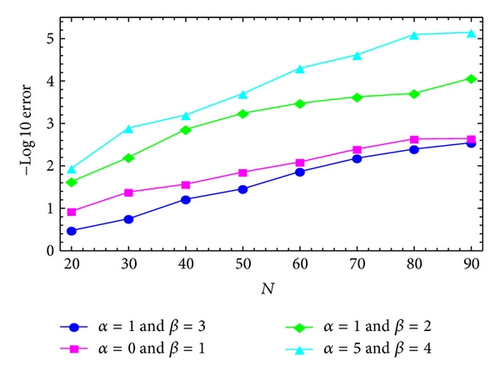
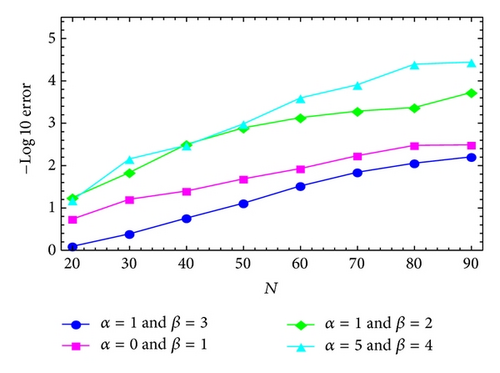
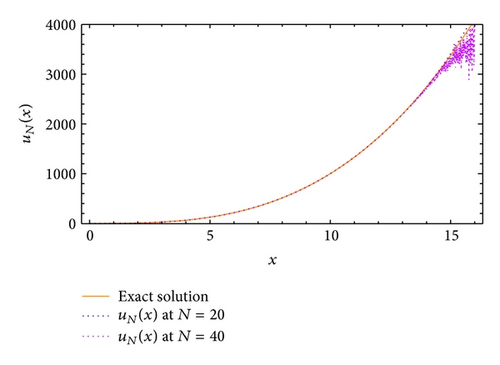
Example 4. Consider the equation
| N | α | β | ν | MGLT(G) | MGLT(GR) | ν | MGLT(G) | MGLT(GR) | ν | MGLT(G) | MGLT(GR) |
|---|---|---|---|---|---|---|---|---|---|---|---|
| 10 | 0 |
|
|
1.32 · 10−2 | 2.24 · 10−2 |
|
8.48 · 10−2 | 1.41 · 10−1 |
|
6.54 · 10−3 | 1.07 · 10−2 |
| 30 | 1.35 · 10−4 | 1.78 · 10−4 | 1.37 · 10−3 | 1.82 · 10−3 | 1.84 · 10−4 | 2.53 · 10−4 | |||||
| 50 | 1.96 · 10−5 | 2.47 · 10−5 | 2.45 · 10−4 | 3.14 · 10−4 | 4.30 · 10−5 | 5.71 · 10−5 | |||||
| 70 | 3.41 · 10−6 | 4.20 · 10−6 | 4.86 · 10−5 | 6.10 · 10−5 | 7.03 · 10−6 | 9.16 · 10−6 | |||||
| 10 |
|
|
|
4.54 · 10−3 | 1.67 · 10−2 |
|
2.36 · 10−2 | 8.98 · 10−2 |
|
1.43 · 10−3 | 5.85 · 10−3 |
| 30 | 2.86 · 10−6 | 8.06 · 10−6 | 2.73 · 10−5 | 8.33 · 10−5 | 2.96 · 10−6 | 1.03 · 10−5 | |||||
| 50 | 8.61 · 10−8 | 2.37 · 10−7 | 1.22 · 10−6 | 3.54 · 10−6 | 1.72 · 10−7 | 5.72 · 10−7 | |||||
| 70 | 1.81 · 10−8 | 5.12 · 10−8 | 2.10 · 10−7 | 6.53 · 10−7 | 3.30 · 10−8 | 1.19 · 10−7 | |||||
| 10 |
|
|
|
4.92 · 10−3 | 2.27 · 10−2 |
|
2.77 · 10−2 | 1.33 · 10−1 |
|
8.80 · 10−3 | 1.67 · 10−3 |
| 30 | 2.83 · 10−6 | 1.01 · 10−5 | 2.71 · 10−5 | 1.06 · 10−4 | 3.00 · 10−6 | 1.35 · 10−5 | |||||
| 50 | 7.88 · 10−8 | 2.73 · 10−7 | 5.48 · 10−7 | 2.19 · 10−6 | 6.94 · 10−8 | 3.25 · 10−7 | |||||
| 70 | 1.49 · 10−8 | 5.30 · 10−8 | 1.74 · 10−7 | 6.87 · 10−7 | 2.72 · 10−8 | 1.26 · 10−7 | |||||
Example 5. We next consider the following:
The solution of this problem is obtained by applying the technique described in Section 4. The maximum absolute error for γ = {0.1 and 0.01} and various choices of N, α, β, and ν are shown in Tables 2 and 3; moreover, the right-hand side is treated by modified generalized Laguerre Gauss and modified generalized Laguerre-Gauss-Radau quadratures.
| N | α | β | ν | MGLT(G) | MGLT(GR) | ν | MGLT(G) | MGLT(GR) | ν | MGLT(G) | MGLT(GR) |
|---|---|---|---|---|---|---|---|---|---|---|---|
| 10 | 0 |
|
|
7.97 · 10−4 | 2.47 · 10−3 |
|
7.28 · 10−5 | 1.40 · 10−4 |
|
1.10 · 10−4 | 1.89 · 10−4 |
| 30 | 1.38 · 10−4 | 3.81 · 10−4 | 7.11 · 10−6 | 1.21 · 10−5 | 7.36 · 10−6 | 1.11 · 10−5 | |||||
| 50 | 4.02 · 10−5 | 1.09 · 10−4 | 1.51 · 10−6 | 2.49 · 10−6 | 1.29 · 10−6 | 1.88 · 10−6 | |||||
| 70 | 2.51 · 10−5 | 6.64 · 10−5 | 3.79 · 10−7 | 6.15 · 10−7 | 5.86 · 10−7 | 8.41 · 10−7 | |||||
| 10 |
|
|
|
5.39 · 10−4 | 4.44 · 10−3 |
|
6.29 · 10−5 | 2.78 · 10−4 |
|
9.84 · 10−5 | 3.54 · 10−4 |
| 30 | 1.33 · 10−5 | 9.33 · 10−5 | 8.65 · 10−7 | 3.20 · 10−6 | 9.31 · 10−7 | 2.77 · 10−6 | |||||
| 50 | 4.26 · 10−6 | 3.00 · 10−5 | 1.99 · 10−7 | 7.37 · 10−7 | 1.71 · 10−7 | 5.06 · 10−7 | |||||
| 70 | 1.78 · 10−6 | 1.22 · 10−5 | 7.56 · 10−8 | 2.72 · 10−7 | 5.28 · 10−8 | 1.52 · 10−7 | |||||
| 10 |
|
|
|
1.19 · 10−4 | 1.87 · 10−3 |
|
1.67 · 10−5 | 1.34 · 10−4 |
|
2.93 · 10−5 | 1.86 · 10−4 |
| 30 | 2.25 · 10−6 | 3.48 · 10−5 | 1.58 · 10−7 | 1.09 · 10−6 | 1.76 · 10−7 | 1.02 · 10−6 | |||||
| 50 | 1.28 · 10−6 | 1.92 · 10−5 | 5.85 · 10−8 | 3.33 · 10−7 | 5.97 · 10−8 | 3.33 · 10−7 | |||||
| 70 | 8.52 · 10−7 | 1.26 · 10−5 | 3.21 · 10−8 | 2.30 · 10−7 | 2.81 · 10−8 | 1.54 · 10−7 | |||||
| N | α | β | ν | MGLT(G) | MGLT(GR) | ν | MGLT(G) | MGLT(GR) | ν | MGLT(G) | MGLT(GR) |
|---|---|---|---|---|---|---|---|---|---|---|---|
| 10 | 0 |
|
|
7.97 · 10−6 | 2.47 · 10−5 |
|
7.28 · 10−7 | 1.40 · 10−6 |
|
1.10 · 10−6 | 1.89 · 10−6 |
| 30 | 1.38 · 10−6 | 3.81 · 10−6 | 7.11 · 10−8 | 1.21 · 10−7 | 7.39 · 10−8 | 1.11 · 10−7 | |||||
| 50 | 4.02 · 10−7 | 1.09 · 10−6 | 1.51 · 10−8 | 2.49 · 10−8 | 1.29 · 10−8 | 1.88 · 10−8 | |||||
| 70 | 2.51 · 10−7 | 6.64 · 10−7 | 3.79 · 10−9 | 6.15 · 10−9 | 5.86 · 10−9 | 8.41 · 10−9 | |||||
| 10 |
|
|
|
5.39 · 10−6 | 4.44 · 10−5 |
|
6.29 · 10−7 | 2.78 · 10−6 |
|
9.85 · 10−7 | 3.54 · 10−6 |
| 30 | 1.33 · 10−7 | 9.33 · 10−7 | 8.65 · 10−9 | 3.20 · 10−8 | 9.31 · 10−9 | 2.77 · 10−8 | |||||
| 50 | 4.26 · 10−8 | 3.00 · 10−7 | 2.00 · 10−9 | 7.37 · 10−9 | 1.71 · 10−9 | 5.06 · 10−9 | |||||
| 70 | 1.78 · 10−8 | 1.22 · 10−7 | 7.56 · 10−10 | 2.72 · 10−9 | 5.28 · 10−10 | 1.52 · 10−9 | |||||
| 10 |
|
|
|
1.19 · 10−6 | 1.87 · 10−5 |
|
1.67 · 10−7 | 1.34 · 10−6 |
|
2.94 · 10−7 | 1.87 · 10−6 |
| 30 | 2.25 · 10−8 | 3.48 · 10−7 | 1.58 · 10−9 | 1.09 · 10−8 | 1.76 · 10−9 | 1.02 · 10−8 | |||||
| 50 | 1.28 · 10−8 | 1.92 · 10−7 | 5.85 · 10−10 | 4.27 · 10−9 | 5.97 · 10−10 | 3.33 · 10−9 | |||||
| 70 | 8.52 · 10−9 | 1.26 · 10−7 | 3.21 · 10−10 | 2.30 · 10−9 | 2.81 · 10−10 | 1.53 · 10−9 | |||||
Example 6. We consider the equation
- (I)
Regarding a = 1, b = 1, c = 1, e = 1, ν1 = 0.77, ν2 = 1.44, and ν = 3.91, Figures 4 and 5 display the maximum absolute errors using MGLT method with the treatment of right-hand side by modified generalized Laguerre-Gauss and Gauss-Radau, respectively.
- (II)
Regarding a = 1, b = 1, c = 0.5, e = 0.5, , , and , Figures 6 and 7 display the maximum absolute errors using MGLT method with the treatment of right-hand side by modified generalized Laguerre-Gauss and Gauss-Radau, respectively.
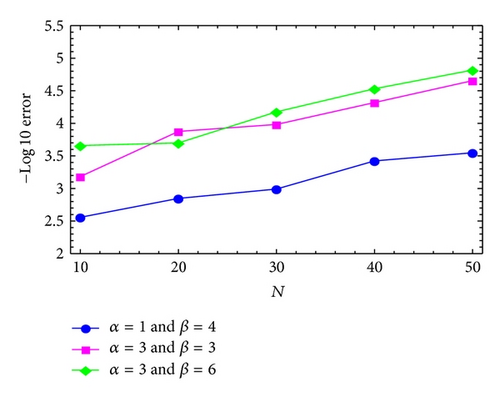
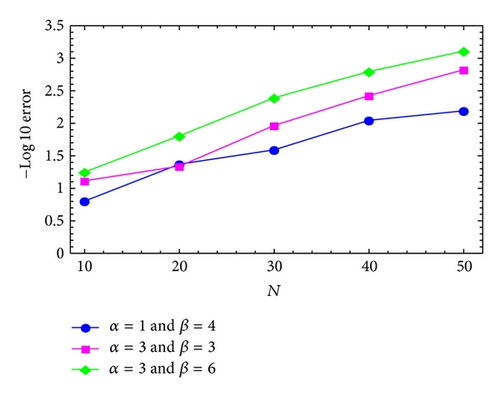
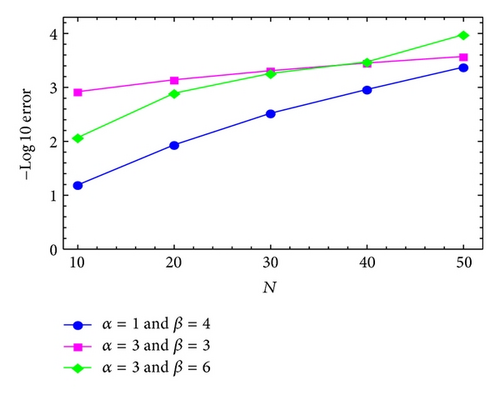
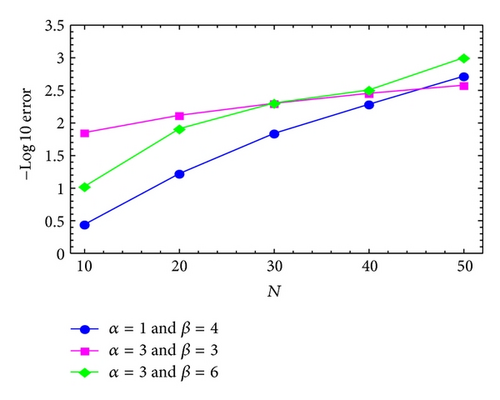
Example 7. Consider the Bagley-Torvik equation with boundary conditions
Bagley-Torvik equation involving fractional derivative of order 3/2 arises in the modeling of the motion of a rigid plate in a Newtonian fluid and a gas in a fluid. We solve this equation with two-point boundary conditions where a = 1, b = 8/17, and c = 13/51 by using modified generalized Laguerre-Gauss and Gauss-Radau quadratures with general parameters α and β. The maximum absolute errors obtained by MGLT method for various choices of N, α, and β are given in Table 4. Moreover, the numerical and exact solutions obtained by the proposed method for α = 2, β = 4, and two choices of N are shown in Figures 8-9 to make it easier to compare with the analytic solution.
| N | α | β | MGLT(G) | MGLT(GR) | α | β | MGLT(G) | MGLT(GR) |
|---|---|---|---|---|---|---|---|---|
| 8 | 0 |
|
1.69 · 10−3 | 3.14 · 10−3 |
|
|
8.98 · 10−5 | 8.21 · 10−4 |
| 16 | 9.97 · 10−4 | 2.35 · 10−3 | 1.98 · 10−5 | 1.91 · 10−4 | ||||
| 32 | 1.57 · 10−4 | 3.50 · 10−4 | 8.50 · 10−6 | 7.89 · 10−5 | ||||
| 64 | 3.52 · 10−5 | 9.97 · 10−5 | 3.81 · 10−6 | 3.72 · 10−5 | ||||
| 8 |
|
|
6.47 · 10−5 | 7.07 · 10−4 |
|
|
8.61 · 10−5 | 1.02 · 10−3 |
| 16 | 1.53 · 10−5 | 1.76 · 10−4 | 2.07 · 10−5 | 2.63 · 10−4 | ||||
| 32 | 6.40 · 10−6 | 7.31 · 10−5 | 6.17 · 10−6 | 8.06 · 10−5 | ||||
| 64 | 3.02 · 10−6 | 3.57 · 10−5 | 3.19 · 10−6 | 4.37 · 10−5 | ||||

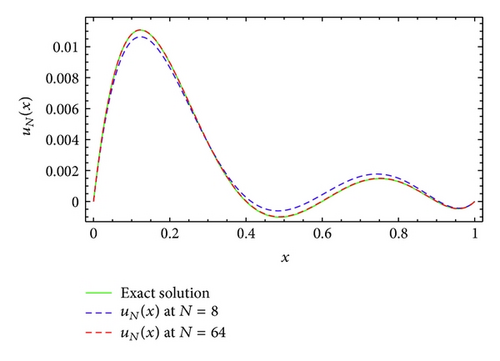
Example 8. We next consider the following nonlinear initial value problem:
The solution of this problem is obtained by applying the modified generalized Laguerre collocation method. The approximate solution obtained by the proposed method for γ = 0.01, α = 2, β = 2, and two choices of N is shown in Figure 10 to make it easier to compare with the analytic solution. Moreover, the absolute error for γ = 0.01, α = 2, β = 2, and N = 20 is given in Figure 11.
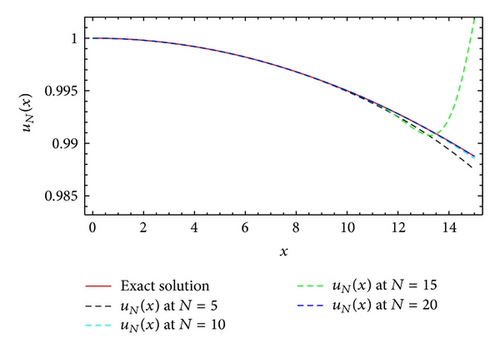
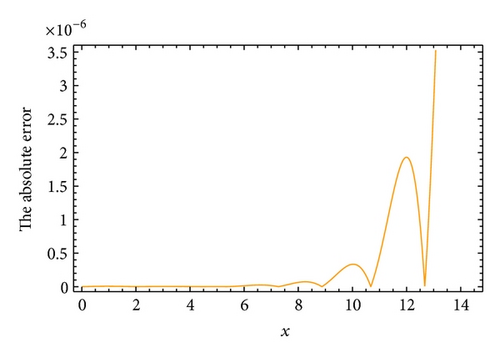
Example 9. Consider the following nonlinear initial value problem:
Comparison between the curves of exact solutions and the approximate solutions at α = 0 and β = 1 of proposed problem subject to u(0) = u′(0) = 0 for the four different fractional orders ν = 1.2, 1.4, 1.6, and 1.8 in case of N = 12 and N = 16 are shown in Figures 12 and 13, respectively. The maximum absolute errors at ν = 1.5 for various choices of α, β, and N in the interval [0,1] are shown in Table 5. Moreover, Figures 14 and 15 display a comparison between the curves of exact solutions and the approximate solutions at α = 0 and β = 1 of proposed problem subject to u(0) = 0 for the four different fractional orders ν = 0.2, 0.4, 0.6, and 0.8 in case of N = 12 and N = 16, respectively. From all the Figures 12–15, it can be seen that the numerical solutions are in complete agreement with the exact solutions for all values of ν. Also, from the numerical results implemented in this example, the classical Laguerre polynomial (α = 0, β = 1), which is used most frequently in practice, is not the best one, especially when we are approximating the solution of fractional differential equations.
| N | α | β | MGLC | α | β | MGLC |
|---|---|---|---|---|---|---|
| 3 | 0 |
|
2.66 · 10−2 |
|
|
2.61 · 10−2 |
| 6 | 2.27 · 10−3 | 3.04 · 10−3 | ||||
| 9 | 1.30 · 10−3 | 1.36 · 10−3 | ||||
| 12 | 5.68 · 10−4 | 7.52 · 10−4 | ||||
| 3 |
|
|
1.39 · 10−2 |
|
|
1.07 · 10−2 |
| 6 | 1.87 · 10−3 | 1.86 · 10−3 | ||||
| 9 | 8.47 · 10−4 | 6.94 · 10−4 | ||||
| 12 | 4.02 · 10−4 | 3.63 · 10−4 | ||||
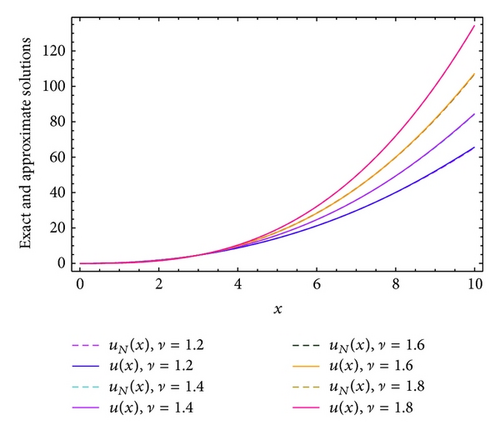
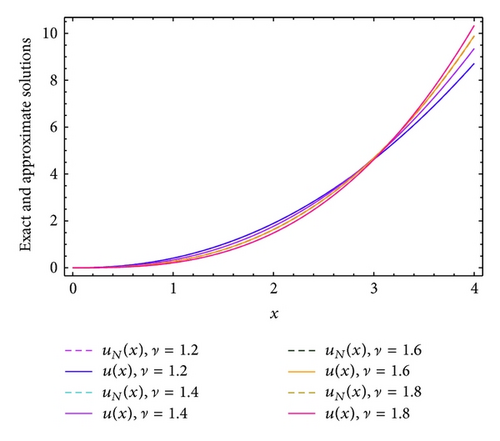
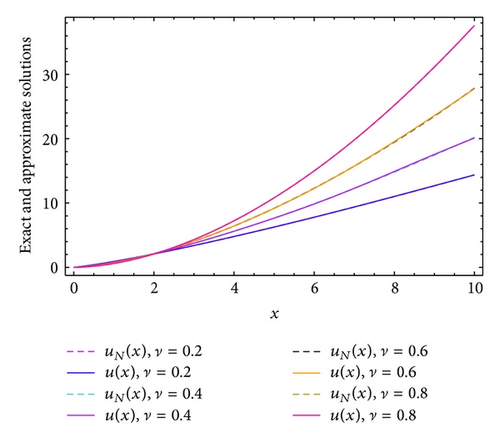
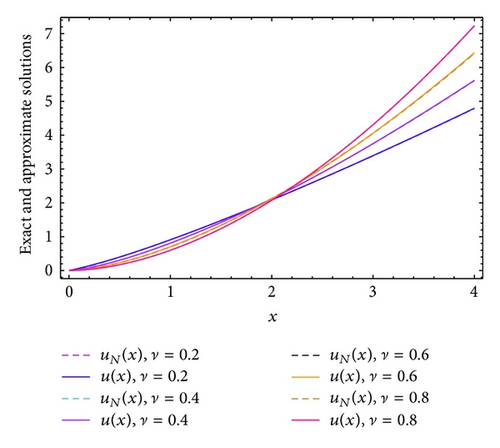
6. Conclusions
In this paper, we have proposed two efficient spectral methods based on modified generalized Laguerre polynomials for tackling linear and nonlinear FDEs on the half line. In these methods, the problem is reduced to the solution of a system of algebraic equations in the expansion coefficient of the solution. Numerical examples were given to demonstrate the validity and applicability of the method. The computational results show that the proposed methods can be effectively used in numerical solution of time-dependent fractional partial differential equation and other problems on the half line.




